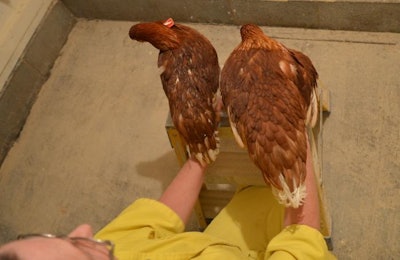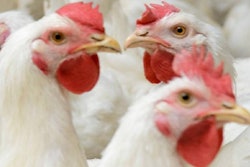
Dr. Ken Anderson, poultry extension specialist at North Carolina State University’s Prestage Department of Poultry Science, explained how farmers can address issues with uniformity in layer pullets in order to maintain healthy flocks performing within breeder standards. Anderson spoke as part of the Organic Egg Farmers of America Symposium on March 14. The event took place in St. Paul, Minnesota, in conjunction with the Midwest Poultry Federation Convention.
Anderson said there are four main issues farmers typically face when dealing with marginal pullets: underweight pullets; overweight pullets; non-uniform pullets which cause poor flock uniformity; and untrained pullets, or pullets not ready to live in alternative housing systems.
Identifying weight issues
When pullets arrive, Anderson said farmers should follow four steps to determine the flock’s uniformity and alignment with breeder weight standards for their age:
- Look up the breeder’s standard weight for your breed, strain and age of pullet.
- Weigh a representative sample of the pullets upon their arrival to the farm.
- Calculate an average pullet weight.
- Determine the flock’s uniformity.
Rather than weighing the first few birds off the truck, farmers need to pick a variety of birds from throughout the flock. At least 100 weights should be collected. Anderson said uniformity is derived from the individual weights of the 100 hens sampled.
“For example, if the average weight is 2.5 pounds then plus or minus 10 percent of the average weight would be the range of 2.25 to 2.75 pounds. If 90 percent of the birds fall within that range, that is fantastic,” Anderson said. “What that means is that 90 percent of the hens will have the same basic requirements for optimal production.”

In order to understand a flock's uniformity and alignment with breeder standards, a representative sample of the birds must be weighed. | Courtesy Dr. Ken Anderson, North Carolina State University
Ideally, for a uniform flock, 80 to 90 percent of the flock is within a goal bodyweight. Anderson said the more uniform the flock, the higher the egg production during the laying phase.
“If only 80 percent of the hens meet that standard, then your dietary program may need to be shifted so that the smallest birds will meet the optimal nutrient consumption for production. It also means that there will be a number of hens which are overeating, which can negatively influence performance in the long term,” he said.
Body weight management
Pullets being under- or overweight can be caused by one main issue: not properly transitioning the rearing diet. This can be caused by improper monitoring of the pullet growth rate due to a poor sampling method often caused by taking too few samples, or it can be caused by pullets being kept on a specific phase feed – starter, grower, developer – for too long. Too much or too little protein in the diet can cause abnormal weights.
If dietary changes are made to address weight issues, farmers must remember results won’t be seen for three to four weeks. It will depend upon personal experience to determine what the flock’s growth curve will do after adjusting feeding habits. No matter the conditions, Anderson cautioned farmers against restricting feed for layer pullets because it will harm them later in life.
Underweight pullets
Underweight birds can be caused by several factors like poor quality chicks that grow into birds that do not match the breeder standards, too many pullets being reared in the same house creating intense competition for food and water, and environmental stress from abnormally high or low temperatures inside the rearing house.
When trying to transition an underweight pullet into lay, farmers must think about what the flock needs as it comes into egg production. A pullet is still growing, adding weight and increasing the size of its body as well as developing a reproductive system. The bird must be fed with the nutrients necessary to develop its first egg and strengthen its reproductive system for its productive lifespan.
Additionally, being a bit lighter than the breeder recommends is not necessarily a bad thing, Anderson said. Again, the key is to understand the birds you are working with and how their genetic background will influence their nutritional needs. Body weights of about .25 pounds less than breeder recommendations can be managed with access to nutrient-dense diets designed to help the birds gain weight and maintain a healthy weight through their laying cycle.
The age of the bird is also important in understanding the flock’s needs. Anderson said farmers need to remember birds are still growing at 16 to 18 weeks of age, and if birds are underweight, farmers can delay the onset of maturity using the length of daylight inside the layer house in order to help the bird gain weight and develop a stronger body and skeleton ahead of the first lay. Laying will create a physiological drain on the birds, so higher-protein and higher-energy diets are necessary for immature birds to gain weight.
Improper beak trimming can be another cause of underweight pullets and birds. Anderson said if the bird suffers from a burnt tongue, a severely trimmed or poorly trimmed beak it will adversely affect their ability to eat for their entire lives. Due to poor feed intake, those birds need more nutritionally rich feed in order to perform – particularly calcium and phosphorous.

Underweight pullets, like the bird on the left, and overweight pullets, like the one on the right, can cause issues with flock performance if not properly cared for in the pullet house. | Courtesy Dr. Ken Anderson, North Carolina State University
Overweight pullets
If pullets are overweight, it typically indicates that the birds are carrying an excessive amount of abdominal fat. Overweight birds may also start laying eggs earlier than normal. Anderson said this is linked to the birds maturing too early and can be caused by an improper light schedule promoting a quicker-than-normal maturation.
If pullets are overweight, farmers should first find out what light schedule the birds are on in the rearing barn and adhere to that instead of light stimulating them further. Those pullets should also be fed a slightly lower-protein diet with a moderate calcium level to slow down their maturation and weight gain. The adjusted diet will allow the birds to burn off abdominal fat.
If the pullets are laying eggs before they leave the rearing house, they must be fed a diet that meets the demands created by egg production. Again, a lower-protein diet can help the pullets burn off excess fat during this stage. Farmers with overweight birds must carefully monitor the pullets’ feed consumption, productivity and body weight so the diets can be reformulated as needed to meet the birds' nutritional needs as they mature.
Poor flock uniformity
If farmers are dealing with poor overall flock uniformity – meaning birds are at similar weights but disparate sizes – then the farmer is in a tough feeding situation. The flock should be fed so that the smallest birds are meeting their minimum nutritional needs in order to go into egg production. This feeding pattern, however, creates a condition where the heaviest birds may overeat. The birds will self-regulate, but a farmer must try and keep the heavier birds from overeating and contributing to further flock uniformity issues.
Farmers can try to slow down the heavier birds' growth by not light stimulating the birds right away once they enter the laying house. This tactic may help smaller birds gain weight and improve overall flock uniformity.
Untrained pullets
In alternative housing systems, it’s essential the pullets be raised in conditions that closely match the laying house. Anderson said the main issue is that birds raised in conventional housing do not know how to survive in an alternative housing situation – resulting in poor use of feeding and drinking equipment as well as underutilization of nest boxes. Pullets must also use the same drinking devices, or be trained with the drinkers they’ll see as adults, or they risk dehydration in the layer house.
Anderson said training for the layer house must start early, otherwise the bird may never learn how to succeed in an alternative system. He said between 12 and 14 weeks of age, farmers need to focus on getting laying pullets acquainted with and comfortable in nest boxes so they can use them for laying when mature.
As for pasture-raised birds, the pullets need outside access, too. The birds can naturally learn to go outside if they are given access to the outdoors, but it can take as long as four weeks for the birds to become comfortable leaving the house and using the pasture. He said farmers can try putting all the birds outside and letting them naturally return to the house over the course of the day in order to make pullets more comfortable outside.


















